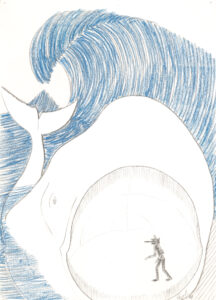
Pinocchio’s first words were: “Don’t hit me so hard!”
This was his first wail to the world, which cries out for mercy and respect. Pinocchio is marked: the axe that wants to shape him represents the reality that wants to mutilate him, shatter him and cage him in a pre-established pattern. Like Nietzsche’s Dionysus, who originates from laceration, Collodi’s Pinocchio is born from suffering, concealed during the journey of his redemption, which reveals the history of oppression and the metaphor of humanity.
It is precisely through this cathartic excursus made up of encounters, astonishment, fear and pain that Pinocchio arrives at his metaphorical degradation into a beast and transcends adversity to achieve humanity. Mario Ceroli, born in 1938, in Abruzzo, in Castel Frentano, a rustic, strong and violent land, raised in wood, washed by ash and nourished by the earth, feels deeply touched by this suffering that he feels is his own and by this multifaceted and pyrotechnic character, with whom one identifies. Like Pinocchio, the artist is born and then reborn in wood; like him, as soon as he comes into the world, he already knows that he must flee, that he must become a nomad and cross distant lands, refusing to be caged first and then used by modern society. The character of Pinocchio fascinates the artist’s creative mind (since 2001 with the first series of ‘Pinocchios’) precisely because of his hybrid and controversial nature, because he wants to live without rules, since he, after all, does not know any rules. He laughs and mocks, he sings and dances and, like a noisy din, he intrigues and attracts the apparent moralisers and cynical impostors, who live the monotony of everyday life, longing for the change that is to come. The curiosity and euphoria, typical of the puppet, remind the artist of the years he lived during the Scuola di Piazza del Popolo, the enthusiasm that hovered among the artists, the fantastic atmosphere they breathed and their shared desire for discovery. A sehnsucht, a longing for desire, which used to be possible because there was the joy of creating for its own sake, and which now seems to be disappearing. Today, the joy of living has turned into boredom and a cold market perspective; one can only ask oneself: is desire legitimate? Without interference, without any real or symbolic castration?”
For Ceroli this is possible, since he is Pinocchio and at the same time Geppetto: he is emotionality and wisdom, patheticity and nostalgia, two sides of the same coin, linked and distinct, in an indissoluble pair. The artist himself defines himself as a “carpenter”, understood as the one who gives life to wood: the conscience that, like the Talking Cricket, gives it a moral and shapes its soul by creating a work of art.





















